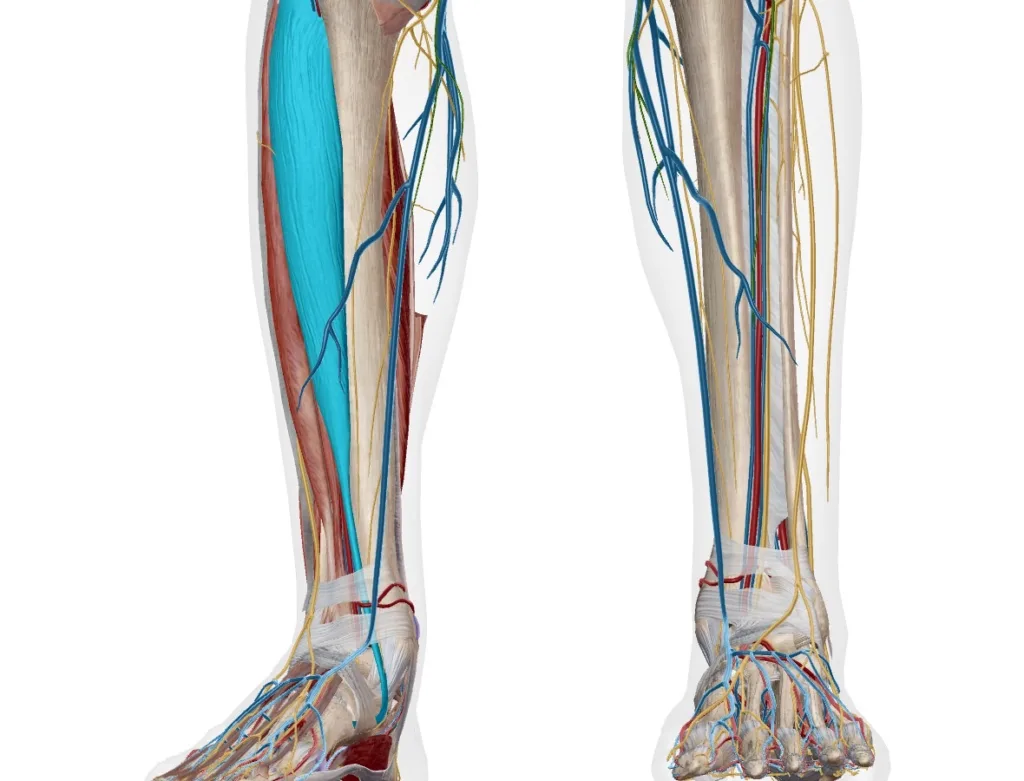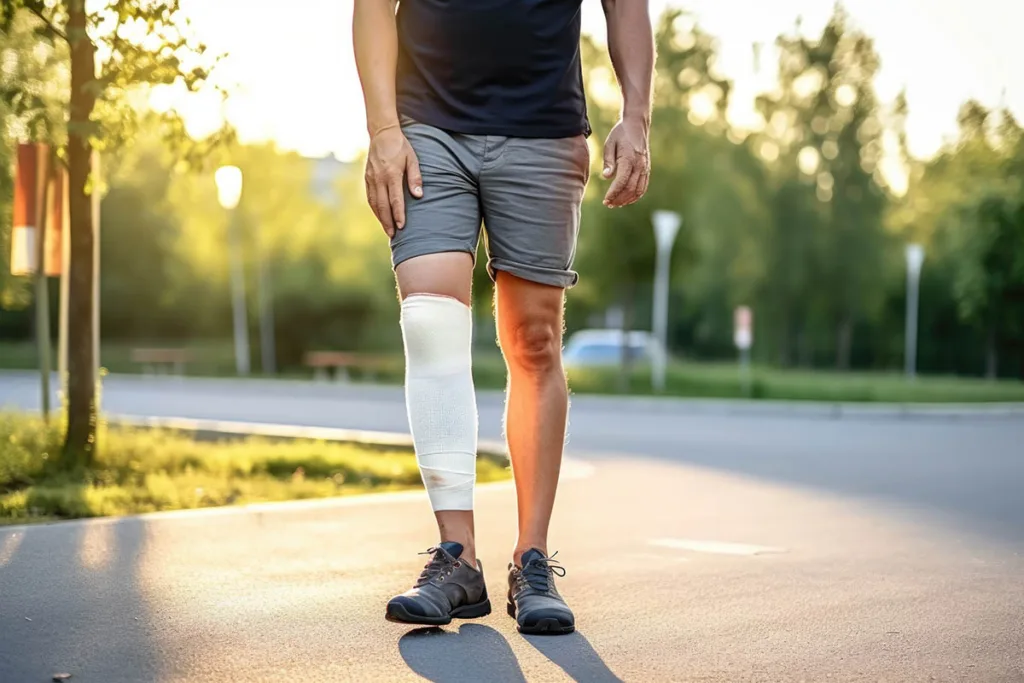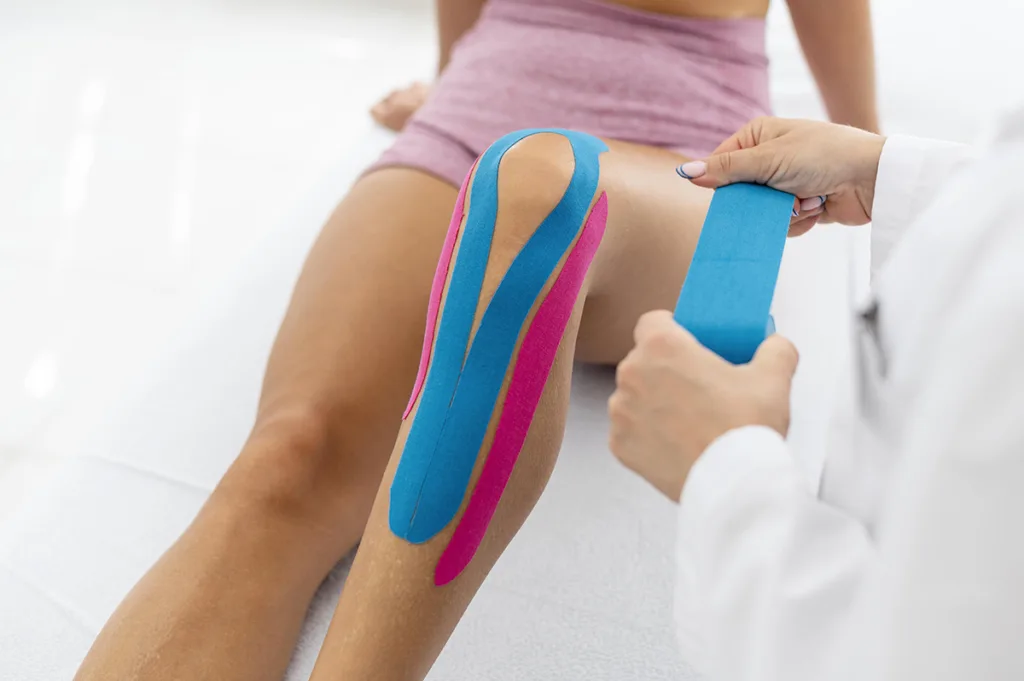Are you tired of the nagging pain and discomfort caused by shin splints? Seeking relief from this common condition is crucial for athletes, fitness enthusiasts, and anyone experiencing lower leg discomfort. Fortunately, in Thailand, specialized tips and treatments are available to alleviate the symptoms of shin splints syndrome. But what are these relief techniques, and how can they help you overcome shin splints? Let’s explore the causes, symptoms, and treatment options for shin splints syndrome, with a focus on the specialized care available in Thailand.
Key Takeaways:
- Shin splints syndrome is a common condition that causes pain and discomfort in the lower leg.
- In Thailand, there are specialized tips and treatments available to provide relief from shin splints.
- Understanding the causes and risk factors associated with shin splints is crucial for prevention and treatment.
- The RICE method (Rest, Ice, Compression, Elevation) can provide effective relief for shin splints.
- Engaging in specific exercises and activities can help prevent the onset of shin splints.
Understanding Shin Splints Syndrome
Shin splints syndrome, also known as medial tibial stress syndrome, is a common condition characterized by acute pain along the tibia (shin bone) due to inflammation of the tendons and muscles in the area. It mainly affects individuals who engage in repetitive activities or high-impact sports.

The Basics of Medial Tibial Stress Syndrome
Medial tibial stress syndrome (MTSS) occurs when the muscles and tendons in the lower leg become overworked and inflamed. The repetitive stress and impact placed on these structures can lead to microtears and irritation, resulting in pain and discomfort.
The primary cause of this condition is typically attributed to biomechanical issues, such as improper running or walking technique, inadequate footwear, or training on hard surfaces. Other factors, including muscle imbalances, increased training intensity or duration, and poor recovery, may also contribute to the development of MTSS.
Prevalence Among Athletes and Fitness Enthusiasts
Shin splints have a high prevalence among athletes and fitness enthusiasts, particularly in Thailand, where a strong sporting culture exists. The repetitive nature of activities like running, jumping, and sports that involve sudden changes in direction can significantly increase the risk of developing shin splints.
Athletes and individuals who participate in activities that involve frequent high-impact movements, such as basketball, soccer, and dance, are particularly susceptible to this condition. Furthermore, individuals who have recently increased their training intensity or have abruptly changed their exercise regimen may be at a higher risk.
It is crucial to understand the prevalence of shin splints among athletes and fitness enthusiasts to raise awareness about the condition and encourage proactive measures to prevent and manage it effectively.
| Shin Splints Prevalence | Sports Affected |
|---|---|
| 45% | Running |
| 33% | Basketball |
| 22% | Soccer |
| 12% | Dance |
Identifying Shin Splints: Symptoms to Watch For
In order to seek appropriate treatment for shin splints, it is important to be able to identify the key symptoms associated with this condition. By recognizing these signs, individuals can take proactive steps towards finding relief and preventing further complications.
Pain and Tenderness Along the Tibia
One of the primary symptoms of shin splints is pain and tenderness along the tibia, the large bone located in the lower leg. This pain can range from a dull ache to a sharp, stabbing sensation, and is often characterized by its location on the inner edge of the shin bone.
Individuals experiencing shin splints may also notice increased sensitivity when pressure is applied to the affected area. This tenderness can make it challenging to walk or engage in physical activities that involve the lower legs.
Swelling and Discomfort During Exercise
Another common symptom of shin splints is swelling and discomfort during exercise. As individuals engage in activities that put strain on the lower legs, such as running or jumping, they may notice their shins becoming swollen and painful.
This swelling typically occurs as a result of inflammation in the muscles and tendons surrounding the tibia. It can make it difficult to continue exercising and may even cause individuals to have to stop their activities altogether.
| Symptoms of Shin Splints | Description |
|---|---|
| Pain and tenderness along the tibia | Sharp or dull ache felt on the inner edge of the shin bone, increased sensitivity when pressure is applied. |
| Swelling and discomfort during exercise | Inflammation in the muscles and tendons surrounding the tibia, resulting in swelling and pain that can interfere with physical activities. |

Shin Splints Syndrome: Causes and Risk Factors
Understanding the causes and risk factors associated with shin splints is crucial for prevention and treatment. This section will explore the impact of repetitive activities and sports on the development of shin splints, as well as the influence of footwear and training surfaces.
Impact of Repetitive Activities and Sports
Engaging in repetitive activities and sports can significantly contribute to the development of shin splints. The constant stress and impact placed on the legs during activities such as running, jumping, and dancing can lead to inflammation and pain in the lower leg. Activities that involve sudden changes in direction or excessive force can also increase the risk of developing shin splints.
To prevent shin splints caused by repetitive activities, it is important to gradually increase the intensity and duration of your workouts. Incorporating cross-training exercises that reduce the impact on your legs, such as swimming or cycling, can also help minimize the risk.
Influence of Footwear and Training Surfaces
The type of footwear and training surfaces you use can have a significant impact on the development of shin splints. Worn-out or unsupportive shoes can cause improper foot and leg alignment, increasing the stress on the shin bones and muscles. Similarly, training on hard or uneven surfaces can intensify the impact on your legs, leading to shin splints.
To reduce the risk of shin splints related to footwear and training surfaces, it is essential to choose proper footwear that provides adequate cushioning and support. Regularly replacing worn-out shoes and using orthotic inserts if needed can help maintain proper foot alignment. Additionally, opting for softer surfaces for training, such as grass or rubber tracks, can help minimize the impact on your legs.
Shin Splints Relief: The RICE Method Explained
When it comes to finding relief from shin splints, the RICE method (Rest, Ice, Compression, Elevation) is a tried and true approach. This method focuses on reducing pain and inflammation in the affected area, allowing for faster recovery and improved comfort.
Rest is the first step of the RICE method. It involves taking a break from activities that exacerbate the symptoms of shin splints, such as running or high-impact exercises. By giving the body time to heal, rest plays a crucial role in the recovery process.
Ice is an effective way to reduce inflammation and alleviate pain. Applying an ice pack or cold compress to the affected area for around 15-20 minutes several times a day can provide significant relief. It is important to wrap the ice pack in a thin cloth to protect the skin and avoid direct contact.
Compression helps minimize swelling and offers support to the muscles and tendons in the shin. Using an elastic compression bandage or shin splint sleeve can help reduce inflammation and provide stability during activity. However, it is essential not to make the compression too tight, as it may restrict blood flow.
Elevation is another aspect of the RICE method that can aid in reducing swelling. Elevating the leg above heart level helps promote blood flow away from the affected area, reducing inflammation and accelerating the healing process. Propping the leg up on a pillow or cushion while resting or sleeping can provide relief.
The RICE method is a simple yet effective way to relieve the symptoms of shin splints. By combining these four components to create a comprehensive treatment plan, individuals suffering from shin splints can experience improved comfort and faster recovery.
| RICE Method | Explanation |
|---|---|
| Rest | Take a break from activities that exacerbate shin splint symptoms. |
| Ice | Apply ice or a cold compress to reduce inflammation and alleviate pain. |
| Compression | Use an elastic compression bandage or shin splint sleeve to reduce swelling and provide support. |
| Elevation | Elevate the leg above heart level to promote blood flow away from the affected area and reduce swelling. |
Can Exercise Contribute to Shin Splints Prevention?
Engaging in specific exercises and activities can help prevent the onset of shin splints. By incorporating low-impact activities into your routine, you can promote shin health and reduce the risk of developing shin splints. Additionally, knowing how to transition back to running after recovering from shin splints is essential for a successful return to your regular running routine.
Low-Impact Activities for Shin Health
When it comes to preventing shin splints, low-impact activities are key. These exercises minimize the stress placed on the shins while still providing a challenging workout. Consider incorporating the following activities into your fitness regimen:
- Swimming: Water provides resistance without the impact of running, making it an excellent choice for shin splints prevention.
- Cycling: Whether outdoor or indoor, cycling is a low-impact activity that strengthens the leg muscles while reducing strain on the shins.
- Elliptical Training: Using an elliptical machine allows for a smooth, fluid motion that is gentler on the shins compared to running.
- Yoga/Pilates: These mind-body practices focus on flexibility, strength, and balance, providing a well-rounded approach to shin health.
Transitioning Back to Running Post-Injury
After recovering from shin splints, it is important to approach running with caution to avoid re-injury. Follow these tips for a gradual and safe return:
- Start with Walk-Run Intervals: Begin with a combination of walking and running intervals to gradually reintroduce impact to your shins.
- Listen to Your Body: Pay attention to any discomfort or pain during your runs. If you experience shin pain, take a break and give yourself more time to recover.
- Gradually Increase Distance and Intensity: Slowly increase the duration and intensity of your runs over time. Remember to give your body enough rest between workouts.
- Invest in Proper Footwear: Ensure that you have supportive running shoes that fit well and provide adequate cushioning and stability.
- Consider Orthotic Inserts: If you have specific foot mechanics or pronation issues, orthotic inserts can help support your feet and reduce stress on your shins.
By following these guidelines and gradually incorporating low-impact activities, you can contribute to shin splints prevention and safely transition back to running after recovering from this common condition.
Conventional and Alternative Treatments in Thailand
In Thailand, individuals suffering from shin splints have access to a range of treatment options. These treatments aim to provide relief from shin pain and aid in the recovery process. Conventional treatments, as well as alternative therapies, can be utilized to alleviate symptoms and promote healing.
TECAR Therapy: Potential Benefits for Shin Pain
TECAR therapy, also known as Capacitive and Resistive Energy Transfer (CRET), is a state-of-the-art treatment that has shown promising results in managing shin splints. This non-invasive procedure involves the use of electromagnetic energy to stimulate healing and reduce pain. TECAR therapy has several potential benefits for individuals experiencing shin pain:
- Improved blood circulation: TECAR therapy increases blood flow to the affected area, promoting the delivery of oxygen and nutrients to aid in healing and reduce inflammation.
- Accelerated tissue regeneration: The electromagnetic energy of TECAR therapy stimulates cellular activity, which can enhance tissue repair and regeneration, speeding up the recovery process for shin splints.
- Pain relief: By reducing inflammation and promoting healing, TECAR therapy can provide significant pain relief for individuals with shin splints, allowing them to resume their regular activities more comfortably.
- Non-invasive and drug-free: TECAR therapy is a non-invasive treatment option that does not involve surgery or medication. This makes it a safe and drug-free alternative for individuals seeking relief from shin splints.
Remedial Massage: Aiding Recovery Through Professional Care
Remedial massage is another treatment option that can play a significant role in the recovery process of shin splints. This therapeutic technique focuses on relieving muscle tension, reducing inflammation, and improving circulation. Here are some ways in which remedial massage can aid in shin splints recovery:
- Muscle relaxation: Shin splints often result from tight and overworked muscles. Remedial massage can target these muscles, releasing tension and promoting relaxation, which can help alleviate pain and discomfort.
- Inflammation reduction: Through targeted massage techniques, remedial massage can help reduce inflammation in the affected muscles and tendons, facilitating the healing process and accelerating recovery.
- Improved flexibility and range of motion: Shin splints can cause stiffness and limited range of motion. Remedial massage can help increase flexibility, release muscle restrictions, and enhance overall movement in the lower leg area.
- Professional guidance: Seeking remedial massage from a qualified therapist ensures that you receive expert guidance and personalized care tailored to your specific needs. They can assess your condition, develop a treatment plan, and provide ongoing support throughout your recovery journey.
By combining conventional treatments like TECAR therapy with alternative therapies such as remedial massage, individuals with shin splints in Thailand have access to a comprehensive approach to their treatment. These therapies address the root causes of shin splints, alleviate pain, and promote a faster and smoother recovery process.
| Treatment | Description |
|---|---|
| TECAR Therapy | A non-invasive treatment that uses electromagnetic energy to stimulate healing, improve blood circulation, accelerate tissue regeneration, and provide pain relief. |
| Remedial Massage | A therapeutic technique focused on relieving muscle tension, reducing inflammation, improving flexibility, and enhancing overall range of motion in the lower leg area. |
Preventative Measures for Shin Splints Syndrome
Targeted Stretching and Strengthening Exercises
One of the most effective ways to prevent shin splints is by incorporating targeted stretching and strengthening exercises into your daily routine. These exercises can help improve the flexibility and strength of the muscles in your lower legs, reducing the risk of developing shin splints. Here are a few exercises that you can try:
- Calf stretches: Stand facing a wall and place your hands on it for support. Step one leg back while keeping the knee straight and press the heel into the ground. You should feel a stretch in your calf. Hold for 30 seconds and repeat on the other side.
- Towel scrunches: Place a small towel on the floor and use your toes to scrunch it up towards you. This exercise helps strengthen the muscles in your feet and lower legs.
- Ankle circles: Sit on a chair with your feet flat on the ground. Lift one foot off the floor and rotate your ankle in a circular motion. Repeat this exercise in both directions for about 10 repetitions on each side.
- Toe raises: Stand with your feet hip-width apart and slowly rise up onto your tiptoes. Hold for a few seconds before lowering back down. Repeat this exercise for 10-15 repetitions.
Incorporate these stretching and strengthening exercises into your routine at least three times a week to help prevent shin splints from occurring.
Proper Footwear and Biomechanical Considerations
Wearing the right footwear is essential for preventing shin splints. Proper shoes provide adequate support and cushioning for your feet and lower legs, reducing the impact and stress on your shins. When choosing footwear, consider the following:
- Opt for shoes specifically designed for the activity you’ll be engaging in. Running shoes are different from basketball shoes or cross-training shoes.
- Ensure that the shoes fit properly and provide ample support for your feet and arches. Consider getting a professional fitting to ensure the right fit.
- Replace your shoes regularly, as worn-out shoes can contribute to injury.
In addition to proper footwear, it’s important to consider your biomechanics when engaging in physical activities. Biomechanical abnormalities, such as overpronation or high arches, can increase the risk of developing shin splints. If you have any concerns about your biomechanics, consult with a healthcare professional or a podiatrist who can assess your gait and recommend appropriate measures, such as orthotic inserts or specialized footwear.
Stretching and Strengthening Exercises for Shin Splints Prevention
| Exercise | Instructions |
|---|---|
| Calf Stretches | Stand facing a wall, place your hands on it for support, and step one leg back while keeping the knee straight. Press the heel into the ground and hold for 30 seconds. Repeat on the other side. |
| Towel Scrunches | Place a small towel on the floor and use your toes to scrunch it up towards you. Repeat this exercise for a few minutes. |
| Ankle Circles | Sit on a chair with your feet flat on the ground. Lift one foot off the floor and rotate your ankle in a circular motion. Repeat in both directions for about 10 repetitions on each side. |
| Toe Raises | Stand with your feet hip-width apart and slowly rise up onto your tiptoes. Hold for a few seconds before lowering back down. Repeat for 10-15 repetitions. |

Medical Interventions and When to Seek Help
In some cases, medical interventions may be necessary to effectively treat shin splints. While many cases can be managed with self-care measures such as the RICER method discussed earlier, there are instances where seeking professional help is crucial for proper diagnosis and treatment.
From RICER to Specialist Consultation
When self-care measures fail to provide relief or if symptoms worsen, it is advisable to seek medical attention. A healthcare provider, such as a sports medicine physician or orthopedic specialist, can assess the severity of the shin splints and recommend appropriate interventions.
The medical interventions for shin splints may include:
- Physical Therapy: A physical therapist can provide targeted exercises and modalities to promote healing, strengthen the affected muscles, and improve biomechanics.
- Orthotics: Custom orthotic inserts can be prescribed to correct foot mechanics and reduce stress on the shin bone during weight-bearing activities.
- Medications: Nonsteroidal anti-inflammatory drugs (NSAIDs) may be prescribed to help reduce pain and inflammation in the affected area.
- Cortisone Injections: In severe cases, cortisone injections may be recommended to alleviate pain and reduce inflammation.
If conservative treatments do not provide sufficient relief or if there is suspicion of an underlying condition, further diagnostic tests may be necessary. These tests may include X-rays, MRI scans, or bone scans to assess for potential stress fractures or compartment syndrome.
Understanding Stress Fractures and Compartment Syndrome
Stress fractures are small cracks or breaks in the bone caused by repetitive stress or overuse. They can occur in the shin bone (tibia) and mimic the symptoms of shin splints. If left untreated, stress fractures can lead to more serious complications.
Compartment syndrome is a painful condition that occurs when pressure within the muscle compartments of the lower leg and ankle increases. This pressure can impede blood flow, damage muscles, and nerves. While compartment syndrome is less common than shin splints, it is important to be aware of the symptoms and seek immediate medical attention if suspected.
Table: Comparison of Shin Splints, Stress Fractures, and Compartment Syndrome
| Shin Splints | Stress Fractures | Compartment Syndrome | |
|---|---|---|---|
| Cause | Repetitive stress on the muscles and tendons | Repetitive stress or trauma causing small fractures in the bone | Increased pressure within muscle compartments |
| Symptoms | Pain, tenderness, swelling along the shin | Pain that worsens with activity, localized tenderness | Severe pain, swelling, numbness, muscle weakness |
| Diagnostics | Clinical examination, imaging tests if necessary | X-rays, MRI scans, bone scans | Clinical examination, pressure measurements |
| Treatment | Rest, ice, stretching, strengthening exercises | Rest, immobilization, possible surgery in severe cases | Immediate surgical intervention to relieve pressure |
It is important to have a comprehensive understanding of these potential complications and to seek prompt medical attention if symptoms indicate the presence of stress fractures or compartment syndrome. Proper diagnosis and timely treatment can prevent further damage and ensure a successful recovery.

Customized Treatment Plans at Greenbell Medical Clinic
When it comes to effective treatment for shin splints in Thailand, Greenbell Medical Clinic offers specialized care tailored to each individual’s needs. Our team of experienced medical professionals understands the unique challenges of shin splints syndrome and is dedicated to providing the best possible care.
At Greenbell Medical Clinic, we believe in taking a personalized approach to shin splints treatment. Our expert team will conduct a comprehensive assessment to determine the underlying causes of your condition and develop a customized treatment plan that addresses your specific needs.
We offer a range of innovative treatment options that have been proven to provide relief from shin splints. These may include physiotherapy, shockwave therapy, laser therapy, and more. Our goal is to not only alleviate pain and discomfort but also promote long-term healing and prevention of future injuries.
One of the key advantages of seeking treatment at Greenbell Medical Clinic is our commitment to patient education. We will provide you with the knowledge and tools to manage your shin splints effectively, including guidance on proper footwear, stretching exercises, and other self-care techniques.
At Greenbell Medical Clinic, our mission is to help you regain your active lifestyle and get back to doing the activities you love, pain-free. Don’t let shin splints hold you back – reach out to our dedicated team today and let us provide you with the specialized care you deserve!
Conclusion
Shin splints can be a painful and restrictive condition that affects individuals in Thailand. However, there is hope for relief and recovery. By gaining a proper understanding of the condition and its causes, individuals can take proactive measures to prevent shin splints in the future.
Engaging in low-impact activities and targeted stretching exercises can help strengthen the muscles around the shin, reducing the risk of injury. It is also crucial to wear appropriate footwear and consider biomechanical factors to maintain proper form and minimize stress on the shins.
For those already suffering from shin splints, specialized treatments such as TECAR therapy and remedial massage can provide significant relief. These therapies are available at clinics like Greenbell Medical Clinic in Thailand, where expert care and customized treatment plans are offered.
Remember, your shin health is important. Don’t hesitate to seek professional help and take action to alleviate shin splints. With the right knowledge, prevention strategies, and access to specialized treatments, relief and recovery from shin splints are within reach. Take control of your shin health and enjoy an active, pain-free lifestyle.
What is shin splints syndrome?
Shin splints syndrome, also known as medial tibial stress syndrome, is a condition characterized by acute pain along the shin bone (tibia) due to inflammation of the tendons and muscles in the area.
How common are shin splints among athletes and fitness enthusiasts in Thailand?
Shin splints are quite common among athletes and fitness enthusiasts in Thailand. The repetitive activities and sports they engage in make them more susceptible to developing this condition.
What are the key symptoms of shin splints?
The key symptoms of shin splints include pain and tenderness along the tibia, as well as swelling and discomfort during exercise.
What causes shin splints?
Shin splints are commonly caused by repetitive activities and sports, such as running or jumping. Other factors, such as improper footwear and training surfaces, can also contribute to the development of shin splints.
Can exercise help prevent shin splints?
Yes, engaging in low-impact activities and exercises can help prevent the onset of shin splints. Transitioning back into running post-injury should be done gradually and with caution.
What preventative measures can be taken to avoid shin splints?
Targeted stretching and strengthening exercises, along with wearing proper footwear and considering biomechanical factors, can help prevent shin splints.





